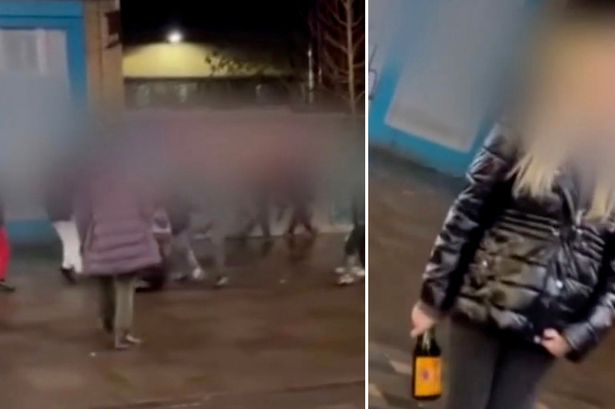The disturbing video, captured in an undisclosed location in Glasgow, depicts a brutal assault on a young boy by a group of his peers. The footage reveals a deeply unsettling scene of violence and apathy, highlighting the severity of youth violence and the bystander effect. The victim, whose identity remains undisclosed, is shown being subjected to a relentless barrage of punches and kicks from multiple assailants. His attempts to defend himself are futile against the coordinated attack, leaving him vulnerable and defenseless. The attackers display a chilling lack of remorse, their aggression escalating throughout the duration of the assault. The violence unfolds in broad daylight, suggesting a brazen disregard for consequences and a disturbing normalization of such behavior within the group.
Adding to the disturbing nature of the incident is the presence of a group of girls who witness the entire ordeal while laughing and recording the assault on their phones. Their inaction and amusement underscore a concerning level of desensitization to violence and a lack of empathy for the victim. Rather than intervening or seeking help, they appear to revel in the spectacle, effectively becoming complicit in the abuse. This passive observation transforms them from mere bystanders to active participants in the perpetuation of violence, fostering a climate where such brutality is not only tolerated but encouraged. The video raises serious questions about the influence of social media and peer pressure in normalizing and even glorifying violent acts among young people.
Further adding to the complexity of the situation is the intervention of a Good Samaritan who attempts to stop the assault. Risking his own safety, this individual steps in to defend the vulnerable boy, demonstrating a courage and compassion conspicuously absent in the other onlookers. However, the intervention is met with hostility, as the aggressors swiftly turn their violence upon the Good Samaritan. This shocking escalation highlights the dangers faced by those who intervene in such situations and underlines the pervasive nature of the aggression within the group. The attackers’ willingness to redirect their violence towards someone attempting to help demonstrates a disturbing lack of restraint and a disregard for any form of authority or moral imperative.
The incident has sparked widespread outrage and concern, prompting calls for action to address the underlying issues contributing to youth violence. Experts suggest that a multi-pronged approach is needed, encompassing early intervention programs, improved educational resources, and community-based initiatives aimed at promoting positive social behavior. Addressing the root causes of such violence, including social inequality, lack of opportunity, and exposure to violence in the home or community, is crucial. Moreover, strategies to combat the bystander effect, emphasizing the importance of intervening and reporting such incidents, are essential. Promoting empathy, fostering a sense of responsibility, and empowering young people to stand up against violence are critical steps in creating a safer environment for all.
The incident also underscores the potentially harmful influence of social media and the need for responsible digital citizenship. The act of recording and sharing violent content not only amplifies the suffering of the victim but also desensitizes viewers to violence and potentially encourages copycat behavior. Educating young people about the ethical implications of sharing such content and promoting responsible online behavior is paramount. Social media platforms also bear responsibility in actively monitoring and removing violent content and implementing policies that discourage the glorification of violence.
This disturbing incident serves as a stark reminder of the challenges facing communities grappling with youth violence. It highlights the urgent need for comprehensive strategies that address the root causes of violence, promote empathy and prosocial behavior, and empower young people to become agents of positive change. The response to this incident must go beyond condemnation and extend to concrete actions that foster a culture of respect, responsibility, and safety for all. By working together, communities can create environments where violence is not tolerated and where young people are equipped with the skills and resources they need to thrive. The need for proactive intervention, community engagement, and responsible use of technology is paramount in preventing future incidents and building a more peaceful and just society.














